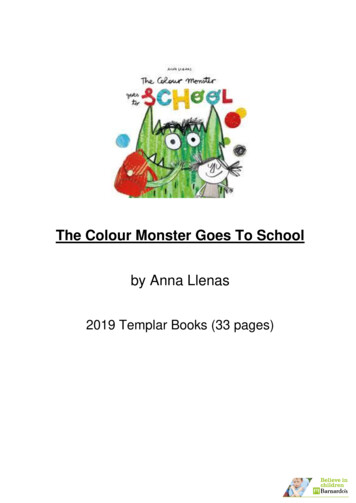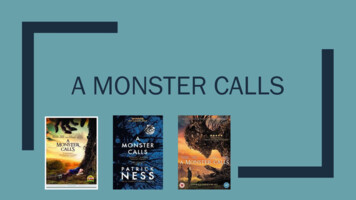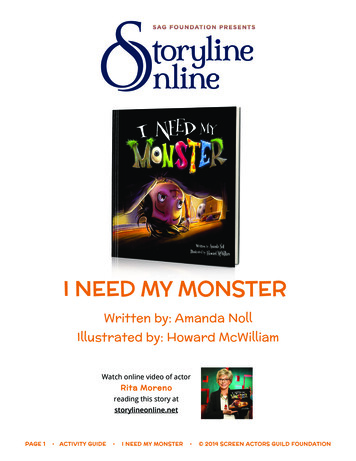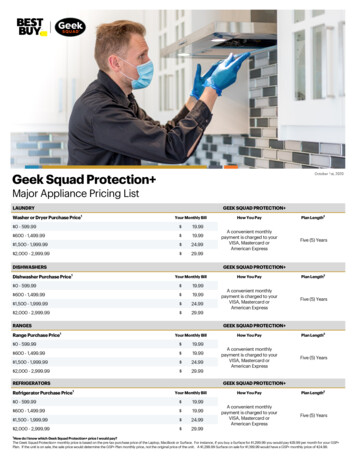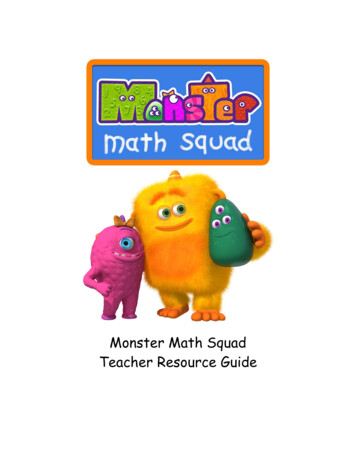
Transcription
Monster Math SquadTeacher Resource Guide
ABOUT THIS TEACHER RESOURCE GUIDEEditing: Courtney White and Min-ji NamLayout and design: Min-ji Nam and Courtney WhiteContributing writers: Min-ji Nam, Courtney White, Kathleen Robson, ArtemisManoukas and Doug Folks. 2014 Canadian Broadcasting Corporation. All rights reserved.This Teacher Resource Guide was produced by the Canadian Broadcasting Corporationin association with Queen’s University’s Faculty of Education.Reproduction rights for this Work are not governed by any license executed byCANCOPY or any other reprography collective.Published by:CBC Learning Curio.caP.O. Box 500, Station AToronto, OntarioCanada M5W 1E6Toll-free: 1-866-999-3072Local: 416-205-6384Fax: 416-205-2376Email: curio@cbc.caWeb: www.curio.ca
Table of ContentsUser Guide . 2Episode 1 Woofie Goes Walking . 3Episode 2 Number Muncher Monster . 9Episode 3 Missing Monster House . 11Episode 4 Big Monster Mess . 13Episode 5 Garbage Monster Delivers . 14Episode 6 Trouble at the Monster Day Care . 16Episode 7 Uncle Gloop’s Big Blunder. 17Episode 8 Big Burp Monster at the Library . 19Episode 9 Monsters at Play . 21Episode 10 Monsters Bowl Meltdown. 23Episode 11 Picky Eater’s Picnic . 26Episode 12 A Muffin Mystery . 29Episode 13 Who’s on First . 30Episode 14 Scary Face Picture Day . 32Episode 15 Monster Hat Mayhem . 34Episode 16 Slime Cream Sundae . 35Episode 17 The Big Stink . 36Episode 18 Monster Muffin Muddle. 38Episode 19 Little Wally Ball-y Monster . 40Episode 20 Monster Hopscotch . 41Episode 21 Sneeze Freeze . 43Episode 22 Monster Garbage Heap . 44Episode 23 The Scoop Troop . 46Episode 24 Monster Tea Party . 47Episode 25 Fall Apart Monster Nose Woes . 49Episode 26 Bucking Monster Mayhem. 50Episode 27 Monster Fang Festival . 51Episode 28 Monster Road Hockey . 52Episode 29 Monster Traffic Trouble. 54Episode 30 A Bungle at Barks and Stench . 55Monster Math Squad, Season 1 · GUIDE · CBC Learning Curio.ca1
User GuideWelcome to Monster Math Squad! JoinGoo, Max and Lily as they team up tosolve the problems of Monstrovia usingthe powers of math.Viewing with Your StudentsBefore you watch - View the episodebefore showing it to your students.Prepare language cards for your Mathword wall and any activities you willneed. Viewing time ranges from 10 to 12minutes, which is ideal for a primaryclassroom. Be prepared to start thelessons right after viewing.While you watch - When your studentsare watching the episode, make sure thatthey get involved. The Monster MathSquad will try to engage young learnersby asking questions. Let students knowit is ok to shout out answers as they areviewing.Organization of UnitsIn each unit you will find information toguide you to effectively use the MonsterMath Squad activities with yourstudents. Each unit includes thefollowing:episode but don’t forget to add your ownas your math program develops.Activities – Each episode has twoactivities. Generally, the first activitywill involve more modeled instructionby the teacher, with the second activityinvolving more independent learning.Activity 1 is designed with the younglearner in mind. These are activities thatintroduce the concept and get thestudents to share their understanding.Activity 2 is an extension on the mathconcept. They will demonstrate theirunderstanding through hands onactivities that involve referring to theirprior knowledge.Curriculum ConnectionsThe materials in this guide were createdby elementary teachers followingCanadian primary math curricula. Theepisodes of Monster Math Squad, inconjunction with the unit activities willassist students to: Develop mathematicalunderstanding in Number Sense,Geometry, Data Managementand Patterning Explore math concepts using avariety of learning styles andapply learning to everyday lifethrough problem solving See connections between mathand other subject areas Develop an enjoyment of mathand its processesSynopsis – To help you prepare yourlesson, a brief synopsis of the episode isprovided to you.Keywords – Encourage students tolisten for the Monster Math Word andshout it out with the Monster MathSquad. Create a special place in yourclassroom to collect and display mathwords; include the words from eachMonster Math Squad, Season 1 · GUIDE · CBC Learning Curio.ca2
Episode 1 Woofie Goes WalkingKey Concept: Identifying shapes in our surroundings and using them to create picturesMath Terms: Shape, Triangle, Circle, Square, StarSynopsisMr. Cranky Pants Monster needs The Monster Math Squad to help walk his pet monsterWoofie while he attends his nephew’s party in the park. The Squad has never met Woofiebefore, so they use their knowledge of SHAPES to get to the door that Woofie is standingbehind.Materials NeededActivity 1: Chart Paper, Shape Cut-Outs or Pattern Blocks, Shape Sorting MatsActivity 2: Shape Cut-Outs or Shape Stickers, GlueActivity 1Mining for ShapesSet up table centres with shape cut-outs (or pattern blocks) and sorting mats (see handout)of each shape (i.e. all table centres will provide shape cut-outs or pattern blocks and foursorting mats). Review all the shapes from the episode together as a class. Allow studentsat their centres to sort the shapes and place them on the correct sorting mat. All studentsat their table centres will pick out square cut-outs and place them on the square sortingmat. They will repeat this process for the remaining shapes.Activity 2Monster MakerUsing shapes (cut-outs or shape stickers) set up a centre for students to make their ownmonster face. Have students place shapes (triangle, circle, square and star) on a monsterbody template (see handout). Remember to encourage students to add interesting monsterfeatures such as horns and tails, not just eyes, nose and a mouth. Encourage the studentsto present their monster face to their peers in partners. In a teacher conference, encouragethe students to use shape language to identify the parts of their shape monster.Extension: Instruct students to use specific number and kind of shapes to create theirown monster face (i.e. create a monster face with two circles, one square, one triangleand two stars)Additional Learning Opportunities9 Modeled & Shared Learning9 Guided & Independent Learning9 Cross-Curricular Opportunities (Art)Monster Math Squad, Season 1 · GUIDE · CBC Learning Curio.ca3
Episode 1 Activity 1Shape Sorting MatsCircleMonster Math Squad, Season 1 · GUIDE · CBC Learning Curio.ca4
SquareMonster Math Squad, Season 1 · GUIDE · CBC Learning Curio.ca5
StarMonster Math Squad, Season 1 · GUIDE · CBC Learning Curio.ca6
TriangleMonster Math Squad, Season 1 · GUIDE · CBC Learning Curio.ca7
Episode 1 Activity 2Monster’s Body TemplateMonster Math Squad, Season 1 · GUIDE · CBC Learning Curio.ca8
Episode 2 Number Muncher MonsterKey Concept: Identifying numbers in order and replacing missing numbers in a sequenceMath Terms: Count (1–10)SynopsisMs. Murkly can’t bake her slimy grimy monster muffins! She has no way to measure theingredients as someone has taken the numbers off her scale. All clues lead to the NumberMuncher Monster as the culprit, and The Monster Math Squad has to COUNT in order tofind out what numbers are missing from Miss Murkly’s scale.Materials NeededActivity 1: Ten-Frames, Buttons or Beans (any items students can use to count with)Activity 2: Ten-Frame Cut-Outs, Blank PaperActivity 1Count Up and DownDemonstrate counting by placing different items on the ten-frames (see handout). Giveeach student a ten-frame and 55 buttons or beans. Have students share the counting outloud while placing the correct number of buttons or beans on the ten-frames. Make surestudents are also including the name of items as they count — “one button, two buttons,three buttons,” etc. Ask students to place different numbers of buttons or beans on theten-frames (e.g. “Show me three beans” or “Show me five beans”). Have students showthe number with their fingers. Repeat the activity for counting down.Activity 2Number SequenceCut out the ten-frames (see handout) so that you have 10 number cards in total. Give eachstudent a set of 10 number cards, but remove one number. Have the students place thenine cards in order identifying the missing number. Once the students are comfortablewith the concept, assist them in gluing the sequence on a piece of paper and writing in themissing numbers with a pencil.Extension: Remove multiple numbers and have the students figure out the missingnumbers.Additional Learning Opportunities9 Modeled & Shared Learning9 Guided & Independent LearningMonster Math Squad, Season 1 · GUIDE · CBC Learning Curio.ca9
Episode 2 Activities 1 & 2Ten Frames1234567891012345678910Monster Math Squad, Season 1 · GUIDE · CBC Learning Curio.ca10
Episode 3 Missing Monster HouseKey Concept: Identifying and ordering by sizeMath Terms: Size, Small, Medium, Large, Order, SortSynopsisMrs. Huge Horn Monster’s monster house went missing and it’s up to The Monster MathSquad to help her find it. The Squad learns about SIZE and uses the difference betweensmall, medium and large to follow the right tracks to the park, where Mrs. Huge HornMonster’s monster house is hiding.Materials NeededActivity 1: Building BlocksActivity 2: Activity Worksheet, Scissors, GlueActivity 1Tower BuildingPick one student to be a volunteer for the demonstration of the activity. Show how tobuild a tower that is smaller than the student, same height as the student and taller thanthe student using blocks. Label the towers as small, medium and large respectively withthe students. Have students go into groups to build their own small, medium and largetowers. Let each group pick one student volunteer to represent how tall a “medium”tower is. Ask students to build a tower that is “shorter” and “taller” than the volunteer.Activity 2Candy HuntHave students cut out the smiley candies from the activity worksheet. Once they’re done,they can glue the correct candies into the appropriate columns of monsters. For example,students should glue the smallest-sized candies into Boo’s column, medium-sized candiesto Lily’s column and large-sized candies to Max’s column.Extension: Have students explain how they knew which candies would go into whichcolumns. Ask students to draw different-sized items that may belong to Max, Lily andBoo. Observe to see if they understand the concepts of small, medium and large fromtheir drawings.Additional Learning Opportunities9 Modeled & Shared Learning9 Guided & Independent LearningMonster Math Squad, Season 1 · GUIDE · CBC Learning Curio.ca11
Episode 3 Activity 2Activity WorksheetThe Monster Math Squad is collecting smiley candies around the town ofMonstrovia. Max, who is a LARGE monster, can only collect LARGE candies.Lily is a MEDIUM-sized monster, so she can only collect MEDIUM-sizedcandies. Goo, the smallest of them all, can only collect SMALL candies. Canyou help the Monster Math Squad collect the correct candies?MaxGooLilyCut hereMonster Math Squad, Season 1 · GUIDE · CBC Learning Curio.ca12
Episode 4 Big Monster MessKey Concept: Sorting items into pairsMath Terms: Pairs, Shape, Pattern, SortSynopsisMr. Cranky Pants Monster is very cranky as the Mess Monster has turned his placeupside down. He calls The Monster Math Squad to help him put his socks into PAIRSand match up Horned Hoots into PAIRS in their cages as he goes to chase after the MessMonster.Materials NeededActivity 1: Coloured Stock Paper, Clothes Pins, MarkersActivity 2: Sticky Memo Pads, MarkersActivity 1Pin itSet up math centres with sets of six primary colour cards (i.e. two blue cards, two redcards, two yellow cards). Colour the tip of the clothes pins with primary colour markersand ensure you have a matching number of clothes pins and colour cards at each mathcentre (i.e. two blue cards with two blue clothes pin, two red cards with two red clothespins, etc.). Demonstrate that the colour on the clothes pins matches the colour of thecards. Have students pin the clothes pins to the matching coloured card. Include otherattributes such as shapes and numbers; draw them on the cards and clothes pins. Havestudents pin the cards again.Activity 2Find Your MatchPrepare sticky notes with a picture of a sock that has two attributes (e.g. blue and fourtoed sock). Ensure you have prepared matching pairs of sticky notes according to thenumber of students in your classroom (e.g. two sticky notes with blue and four-toed socksfor one matching pair). Give each student a sticky note and have students go around theclassroom to find their matching pair. Once pairs have found each other, guide all pairs toexplain how they know that they are pairs.Extension: Challenge the students by placing the sticky notes on students’ backs instead.Allow students to help describe each other’s socks to find their matching pair. Includemore than two attributes for extra challenge (e.g. blue, four-toed, dotted socks).Additional Learning Opportunities9 Physical Activity9 Modeled & Shared Learning9 Guided & Independent LearningMonster Math Squad, Season 1 · GUIDE · CBC Learning Curio.ca13
Episode 5 Garbage Monster DeliversKey Concept: Learning about relationships and attributes by sorting itemsMath Terms: SortSynopsisGarbage Monster can’t deliver garbage to the town of Monstrovia because the new lawrequires him to put the correct garbage in the correct bins and he doesn’t know whichgarbage goes in which bin. The Monster Math Squad learns how to SORT by colour andshape and helps the Garbage Monster by putting the correct garbage in the correct bins.Materials NeededActivity 1: Bins or Sorting mats, Different items representing certain attributesActivity 2: Venn Diagram, Alphabet Cut-OutsActivity 1How are things Same or Different?Using sorting mats or bins, model sorting objects based on established criteria (e.g. circlevs. square, red vs. blue) to the students. Ask eliciting questions to let students think aboutrelationships and how things belong (or don’t belong) together. Place different items onthe carpet and allow students to sort the items in the correct bins. Once they’re done, sortdifferent items into two bins and allow students to guess what the criteria are.Activity 2My name vs. Your nameGive each student the alphabet cut-outs (see handout) of their names (i.e. John will begiven cut-outs of letters J, O, H and N). Students in pairs compare the letters in theirnames and sort them in a Venn diagram (see handout). For instance, John and Jessie bothhave a J in their name. Have students count the number of letters that go in the middle ofthe Venn diagram and record it on the paper (i.e. John and Jessie have only one letter, J,in the middle of their Venn diagram).Extension: Let students go around and compare the letters in their names with otherstudents in the class. Students can try to find the person that shares the most number ofletters in their name.Additional Learning Opportunities9 Modeled & Shared Learning9 Guided & Independent LearningMonster Math Squad, Season 1 · GUIDE · CBC Learning Curio.ca14
Episode 5 Activity 2My Name Vs. Your NameAIQYBJRZCKSDLTEMUFNVGOWMonster Math Squad, Season 1 · GUIDE · CBC Learning Curio.caHPX15
Episode 6 Trouble at the Monster Day CareKey Concept: Introducing the concept of mass and comparing items that are heavy andlightMath Terms: Mass, Lighter, HeavierSynopsisMrs. Mopely, the Monster Day Care teacher, asks The Monster Math Squad to help herlittle monsters with keeping their scary face balloons from floating away. The MonsterMath Squad drops by and helps them out by knowing all about things being LIGHT.Materials NeededActivity 1: Balance Scale, Various heavy and light itemsActivity 2: Balance Scale, Modeling ClayActivity 1Which Object is Heavier?Place a heavy item and a lighter item on a balance. Ask students which item is heavy andwhich item is light. Students guess how many more of the light item needs to go on abalance scale for the two sides to balance. Students go in pairs to collect items around theclassroom that they can measure using a balance scale. They estimate which items will belight and heavy. Have students compare the masses of various items at their desks.Activity 2The Heavy Monster ChallengePass around a lump of clay for students to feel. Challenge students to create a modelingclay monster that they think is heavier than the one that was passed around. Havestudents play around with a lump of clay and make their own clay monster. Once they aredone, let students come to the front to check whether their monster is heavier using abalance scale.Extension: Have students continue to modify their clay monster to achieve the idealmass. Early finishers can go into pairs and estimate whose monster is heavier.Additional Learning Opportunities9 Modeled & Shared Learning9 Guided & Independent Learning9 Cross-Curricular Opportunities (Art)Monster Math Squad, Season 1 · GUIDE · CBC Learning Curio.ca16
Episode 7 Uncle Gloop’s Big BlunderKey Concept: Identifying, creating and extending different A-B patternsMath Terms: Pattern, Repeat, Triangle, CircleSynopsisMr. Cranky Pants’ last customer, Uncle Gloop, mistakenly left with the wrong scooter.The Monster Math Squad learns all about PATTERNS to follow the trail of the missingscooter.Materials NeededActivity 1: Coloured Cubes, Beads or Stickers, Pattern StripsActivity 2: Simple Instruments (if possible)Activity 1Monster CombinationsUsing coloured cubes, beads or stickers, demonstrate creating an A-B pattern to thestudents. Share the pattern with the students and have them extend it by answeringeliciting questions. As concepts develop, have them create their own combinations ofA-B-A and A-B-B patterns on a pattern strip (see handout). For example, A-B-A patternmay be represented as red cube – blue cube – red cube. Have students exchange theirmonster combinations with their peers and extend each other’s patterns.Activity 2Extending Patterns with MusicPart 1Divide the students into three groups: red, blue and green. Write down a repeating red –blue - green pattern. Have students chant their colour group name and stand up in theorder of the pattern. For example, red shouts their name, then blue, then green.Part 2Using the red-blue-green pattern, assign a body percussion sound for each of the colours(or simple instruments if you have them).For example: Red clap, Blue stomp, Green shout hoorayExtension: Have students respond to a variety of A-B-C patterns using their bodypercussion sounds. Encourage students to come up with different body percussion soundsto use.Additional Learning Opportunities9 Physical Activity9 Modeled & Shared Learning9 Guided & Independent Learning9 Cross-Curricular Opportunities (Music)Monster Math Squad, Season 1 · GUIDE · CBC Learning Curio.ca17
Episode 7 Activity 1Pattern StripsMonster Math Squad, Season 1 · GUIDE · CBC Learning Curio.ca18
Episode 8 Big Burp Monster at the LibraryKey Concept: Using numbers to represent different objectsMath Terms: Numbers, Count, Group, OrganizeSynopsisThe Monstrovia library is being shaken to its foundation as Big Burp Monster searchesfor a book! The Monster Math Squad has to learn about NUMBERS to help Miss ShushMonster, the librarian, find the book Big Burp Monster is looking for in the library. TheSquad has to get everything straightened out before he can finally get his book, “How toBurp Really Loud.”Materials NeededActivity 1: Number Hunt Page, Coloured CrayonsActivity 2: MusicActivity 1Number HuntShow students some examples of numbers in the classroom (e.g. on a clock face). Give anumber hunt page (see handout) to each student. Have students go around the classroomto look for numbers that are on the page. When they find a number, let students colour offthe number (e.g. when a student finds the sign “Grade 1” on the classroom door, they cancolour off the number 1 on the number hunt page). The student who has the mostnumbers coloured off will be the winner. Encourage students to write down where theyhave found the number in the text box at the bottom of the page.Activity 2Find a groupBegin by having all students stand in the middle of the classroom. Play a short piece ofmusic and encourage students to move around in a designated spot in the classroom.When music is stopped, call out a number (or write it down on the board), and studentsmust get themselves into groups that match this number. Continue the activity until nomore groups can be formed. Leftover students can help out calling or writing thenumbers.Extension: Call out a number and a specific attribute of students’ clothing. For example,if you call out “Groups of three and red shirt”, students that are wearing red shirts canform groups of three. Ensure you choose attributes that would not eliminate too manystudents from the game all at once.Additional Learning Opportunities9 Physical Activity9 Modeled & Shared Learning9 Guided & Independent LearningMonster Math Squad, Season 1 · GUIDE · CBC Learning Curio.ca19
Episode 8 Activity 1Number 829303131333435363738394041424344454647484950Where did you find these numbers?Monster Math Squad, Season 1 · GUIDE · CBC Learning Curio.ca20
Episode 9 Monsters at PlayKey Concept: Exploring and applying concepts of more than and less thanMath Terms: More, Less, One-to-OneSynopsisA group of little monsters play a game of musical chairs, but they have the same numberof chairs as monsters – no one can seem to win! The Monster Math Squad arrives at thescene to help figure out how to play the game by knowing all about MORE.Materials NeededActivity 1: Paper Plates or Card Stock Paper, Bingo Dabber or StickersActivity 2: Chairs, MusicActivity 1Estimating Using Dot PlatesPart 1: Create Dot PlatesUsing paper plates or stiff card stock paper, use the pattern provided to make a variety ofdot plates or cards. Use a bingo dabber or stickers to represent the 'pips' or the dots on theplates. Try to arrange the dots in a variety of ways as shown (e.g. for a three, make a rowof three dots on one plate and on another plate, arrange the three dots into a triangularpattern.)You should have approximately 15 dot plates or cards like the picture below.Part 2: Using the Dot PlatesHave students estimate the numbers on the plates (recognizing patterns of dots rather thanone-to-one correlation)Monster Math Squad, Season 1 · GUIDE · CBC Learning Curio.ca21
Activity 2Musical ChairsCreate a game of Musical Chairs and explain the rules and concepts of the game:Each “player” has a spot to sit, less one. A short piece of music is played and when themusic stops, players have to compete for a spot. Whoever is left without a seat is “out.”Continue to play, removing one seat at a time, until the remaining players are competingfor just one chair.Extension: Have all students sit on a chair in a big circle. Instead of playing music,teacher says,“Switch seats if you/your ”. For example, if you are wearing a blue shirt, ifyou are wearing glasses, if your favourite color is blue, etc. When the students get up tochange seats, pull away one chair. One student will be left standing without a chair. Thisstudent can call out the next “Switch seats if” question.Additional Learning Opportunities9 Physical Activity9 Guided & Independent LearningMonster Math Squad, Season 1 · GUIDE · CBC Learning Curio.ca22
Episode 10 Monsters Bowl MeltdownKey Concept: Identifying and creating even quantitiesMath Terms: Even, UnevenSynopsisEven Stevie and Even Evie need The Monster Math Squad’s help. These twins likeeverything to be EVEN. The Squad drops by and helps show the twins how to play agame of bowling and keep all the pins even as they go! With a little math, The Squadkeeps everything even. It comes down to the last shot when the twins have to each knockdown one pin at the exact same time!Materials NeededActivity 1: Handout, Square Tiles (or other Math Manipulatives)Activity 2: Worksheet, Die (one per pair of students), DominoesActivity 1Are They Even?Using the worksheet (see handout), students circle the images that contain even numbers.Students can write the number next to the image. Next, they check their work by sortingwith manipulatives (i.e. to check the first answer, try sorting three square tiles evenly).Activity 2Even Vs. OddHave students go into pairs with a die and an activity sheet (see handout). Player 1 willtry to roll even numbers and Player 2 will try to roll odd numbers. Both players will taketurns rolling even or odd numbers. If they roll their number, they can move up one spoton the activity sheet. For example, if Player 1 rolls a two, he or she will move one spot.The winner is the first player to get to the finish spot.Extension: Have students switch their roles (i.e. Player 1 will now be Player 2 and viceversa) and continue the activity. Students can also look at domino pieces and sort theminto even, odd, or both even and odd categories (i.e. numbers that are even on both sideswill be in the “even” category; numbers that are odd on both sides will be in the “odd”category; numbers that are even on one side and odd on the other will be in the “botheven and odd” category).Additional Learning Opportunities9 Guided & Independent LearningMonster Math Squad, Season 1 · GUIDE · CBC Learning Curio.ca23
Episode 10 Activity 1Name:Are they Even?Circle the images that are evenMonster Math Squad, Season 1 · GUIDE · CBC Learning Curio.ca24
Episode 10 Activity 1Even vs. Odd activity sheetFINISHPLAYER 1 (EVEN)PLAYER 2 (ODD)Monster Math Squad, Season 1 · GUIDE · CBC Learning Curio.ca25
Episode 11 Picky Eater’s PicnicKey Concept: Applying the concept of addition in numbers 1–10Math Terms: Add, More, 10, 5, How ManySynopsisPicky Eater Monster is at Barks and Stench General Store trying to figure out exactlyhow many items are needed for the picnic he is planning for his brother Persnickety EaterMonster! The Monster Math Squad helps out and makes sure they have the exact numberof items on the grocery list by learning all about ADDING!Materials NeededActivity 1: Ten Frames, Bingo Stickers or BeansActivity 2: Envelopes, Paper Money TemplateActivity 1Let’s make TenDemonstrate how to make a combination of 10 using different coloured bingo stickers, orbeans on a ten-frame (e.g. five blue and five red or six red beans and four green beans).Have students work with bingo stickers or beans to make four different combinations often. Students should record their combinations using two different coloured markers onthe empty ten-frames (see handout).Activity 2Classroom MarketEncourage parents to help students bring items that they are willing to “sell” to theirpeers during this activity. Students can set up the items at their desks. Teacher can helpstudents come up with the price for each of their items. The prices will be one dollar, fivedollars or 10 dollars. Give each student an envelope filled with paper money (one, five or10 dollars). Each student should get approximately 20 dollars in total. Divide the classinto two, with half of the students acting as “sellers” and the other half being the“shoppers.” Encourage both sellers and shoppers to ask questions regarding the numberand price of items they want to sell or buy — e.g. “How much is this item?” “Can I havetw
Monster Math Squad, Season 1 · GUIDE · CBC Learning Curio.ca 12 Episode 3 Activity 2 Activity Worksheet The Monster Math Squad is collecting smiley candies around the town of Monstrovia. Max, who is a LARGE monster, can only collect LARGE candies. Lily is a MEDIUM-sized monster, so she can only collect MEDIUM-sized candies.

